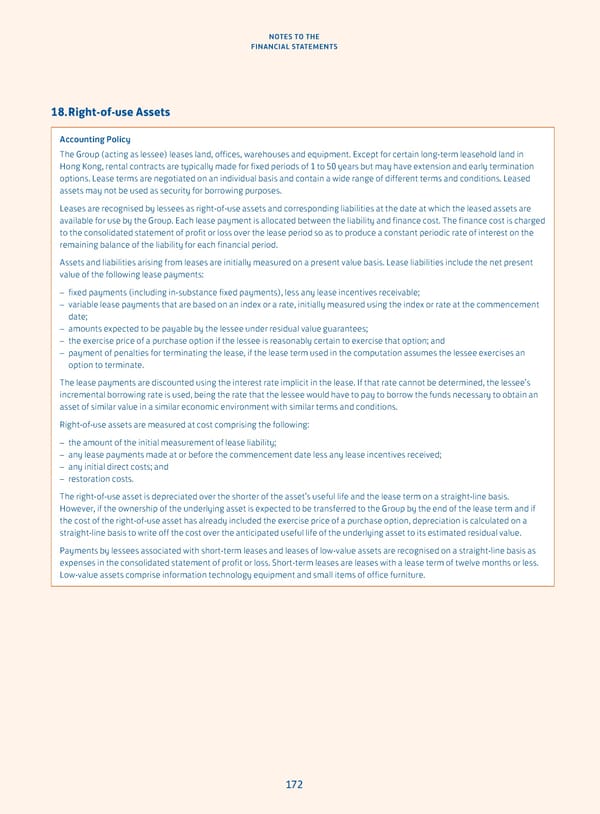NOTES TO THE FINANCIAL STATEMENTS 18. Right-of-use Assets Accounting Policy The Group (acting as lessee) leases land, offices, warehouses and equipment. Except for certain long-term leasehold land in Hong Kong, rental contracts are typically made for fixed periods of 1 to 50 years but may have extension and early termination options. Lease terms are negotiated on an individual basis and contain a wide range of different terms and conditions. Leased assets may not be used as security for borrowing purposes. Leases are recognised by lessees as right-of-use assets and corresponding liabilities at the date at which the leased assets are available for use by the Group. Each lease payment is allocated between the liability and finance cost. The finance cost is charged to the consolidated statement of profit or loss over the lease period so as to produce a constant periodic rate of interest on the remaining balance of the liability for each financial period. Assets and liabilities arising from leases are initially measured on a present value basis. Lease liabilities include the net present value of the following lease payments: – fixed payments (including in-substance fixed payments), less any lease incentives receivable; – variable lease payments that are based on an index or a rate, initially measured using the index or rate at the commencement date; – amounts expected to be payable by the lessee under residual value guarantees; – the exercise price of a purchase option if the lessee is reasonably certain to exercise that option; and – payment of penalties for terminating the lease, if the lease term used in the computation assumes the lessee exercises an option to terminate. The lease payments are discounted using the interest rate implicit in the lease. If that rate cannot be determined, the lessee’s incremental borrowing rate is used, being the rate that the lessee would have to pay to borrow the funds necessary to obtain an asset of similar value in a similar economic environment with similar terms and conditions. Right-of-use assets are measured at cost comprising the following: – the amount of the initial measurement of lease liability; – any lease payments made at or before the commencement date less any lease incentives received; – any initial direct costs; and – restoration costs. The right-of-use asset is depreciated over the shorter of the asset’s useful life and the lease term on a straight-line basis. However, if the ownership of the underlying asset is expected to be transferred to the Group by the end of the lease term and if the cost of the right-of-use asset has already included the exercise price of a purchase option, depreciation is calculated on a straight-line basis to write off the cost over the anticipated useful life of the underlying asset to its estimated residual value. Payments by lessees associated with short-term leases and leases of low-value assets are recognised on a straight-line basis as expenses in the consolidated statement of profit or loss. Short-term leases are leases with a lease term of twelve months or less. Low-value assets comprise information technology equipment and small items of office furniture. 172
 Annual Report 2023 Page 173 Page 175
Annual Report 2023 Page 173 Page 175